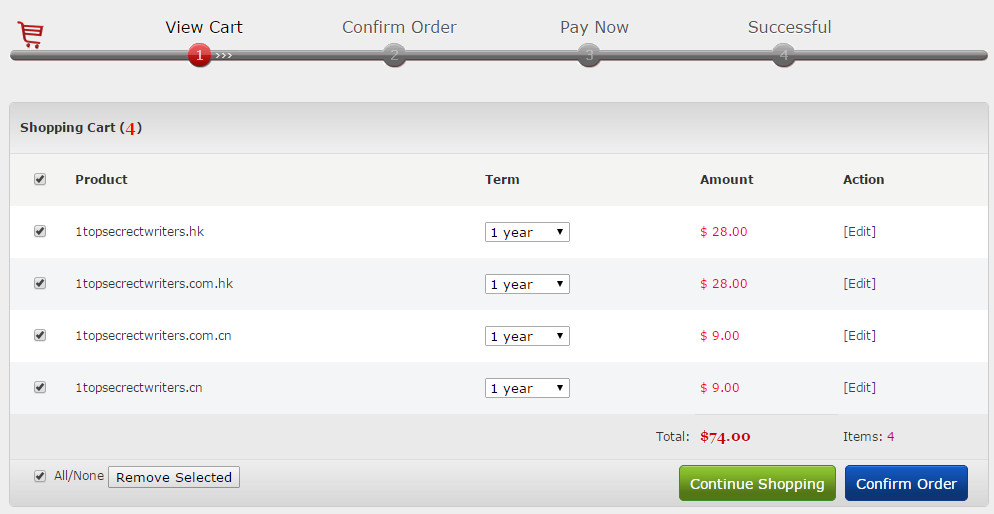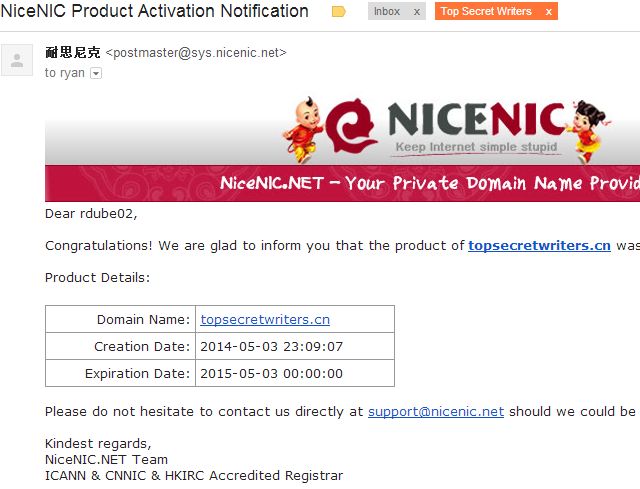Dear Mr. Dube,
My name is Helen Ho, I am the COO of NiceNIC.NET, I represent the entire NiceNIC.NET team to thank you for reporting our company and website in the article posted at http://www.makeuseof.com/tag/spot-chinese-domain-name-scam/. Sorry for the belated Email, we just notice this report today by chance.
I personally love the words of "releaving, breeze, proud, shiny, simple" that you wrote very much, and I am really grateful to our hard-working and attentive staff, it is them who have the glamour to attract so honored customer like you.
We were well encouraged by your article and we would continue working harder to be honest, fair, patient and efficient.
May you and your family be happy, healthy and wealthy!
Sincerely,
Helen Ho, COO
NiceNIC.NET Team
ICANN CNNIC HKIRC Accredited Registrar
>>>>>>
How To Spot A Chinese Domain Name Scam
Ryan Dube wrote on 26th May, 2014
If I offered you a way to protect your car from ever getting stolen, or your house from ever getting broken into, would you pay me for it? Lots of people would — for many people, their brand is just as important as anything else. This is why Chinese domain name scams have become so popular, and so successful.
... ...
* How the Chinese Domain Name Scam Works *
For years, small and large businesses around the world occasionally received emails from individuals reportedly working for a Chinese registrar service, offering a “brand protection” package. The package includes registering a long list of Asia-related domains at a fairly hefty cost per domain.
It is a practice that marketers call “slamming”. Essentially the technique involves some collection of the following tactics:
# Informing you that some third-party company is trying to register your brand within the Asian domain realm.
# Advising you that as a courtesy, the registrar is seeking your “permission” for the third-party to register using your brand name.
# Providing you with first-option to register the Asian domains under your own brand.
# Good cop/bad cop games between the fictional registrar and the alleged 3rd party attempting to register your branded domain.
# Registrations can reportedly take place with a third party email account, so you don’t have direct access to the domains.
# Prices are either abnormally high, limited to 5 to 10 year minimum registrations, or both.
The practice of slamming has increased within the last few months, and should increase even more considering the fact these domains are now accessible to anyone.
* Exposing the Chinese Domain Name Scam *
That one line was perfect, because it was a black and white claim that the Asian domains were registered by someone else. This is a claim that’s easy enough to prove as a lie. All I had to do was go ahead and register the domains legitimately. However, before doing this, I waited about a week to make sure whatever alleged registration processed had actually gone through, then I moved forward with the plan.
First, to find legitimate registrars in China, you should start with the CNNIC, the only organization approved by ICANN to register Asia-Pacific domain names. I actually went with NiceNIC.NET since it’s one that I’d heard of before and is actually registered in the ICANN registry database. Searching for my domain and looking up the prices for .hk and .cn domains was very revealing.

As you can see, a single year for .cn is a paltry $9. Registering .hk is only moderately more expensive. The price claimed in the scam Email was about three times higher.
More importantly, notice that NiceNic did not identify these domains as already being registered by anyone. Submitting registration for these top level CN and HK domains was a breeze, and within barely two days I had received confirmation that I was the proud owner of shiny new top-level Asia domains for my brand.

With access to the Name Servers for the domain, it was a simple process to point those to my own website, and then redirect the .cn domain to the main blog page.

... ...
The moral of this story is, if you receive an email from anyone claiming that your brand is at risk in Asia, the question you should ask yourself is whether that really matters to you if people visit a .cn or .hk website of the same name and visit some other site. The second thing you should do is tell yourself that the threat probably isn’t real. And finally, if you do care about this – by all means register your Asian domains, but do it through a well-known, legitimate registrar that’s listed with ICANN, not through some random person who just emailed you.
PS: A bit of advice from NiceNIC.NET:
Some of our other customers had the same or similar confusion, there is an easy way to spot this kind of scam, that is to check the whois information of the domain name, which is included in the sender’s Email address, and in the whois information, you will obviously see who is the real “Registrar”, 100% possibly it is not the one who claimed that he was the Registrar, because no real Registrar will use so crappy way to get domain orders, and Registrar’s behaviour is seriously supervised by both ICANN and Registry.
Hope it helps! Good luck!

















